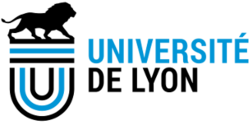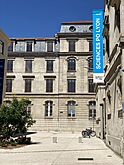University of Lyon facts for kids
|
Université de Lyon
|
|
 |
|
| Motto |
Scienta et Labore
|
|---|---|
| Type | Public |
| Established |
|
| Endowment | €4,000,000 over two years |
| President | Pr. Nathalie Dompnier |
|
Academic staff
|
5,000 |
|
Administrative staff
|
11,500 |
| Students | 145,000 |
| 5,000 | |
| Address |
92, rue Pasteur 69361
,
,
,
France
45°44′53″N 4°51′08″E / 45.748151°N 4.852352°E |
| Campus | Multiple campuses |
| Colors | Blue and Black |
| Website | www.universite-lyon.fr |
The University of Lyon (called Université de Lyon in French) is a large group of universities and schools in Lyon, France. It's like a big team of learning places working together. This group includes 12 main members and 9 other connected schools.
Lyon is the third-largest university city in France, after Paris and Toulouse. It has a huge number of students, about 175,000 in 2024! There are also 11,500 teachers and researchers. The University of Lyon is a very important place for scientific research. It helps private and public schools in the Lyon area work together to discover new things.
The three main universities in this group are:
- Claude Bernard University Lyon 1: This university focuses on health and science. It has around 47,000 students.
- Lumière University Lyon 2: This one is for social sciences and arts. About 30,000 students study here.
- Jean Moulin University Lyon 3: This university teaches law and humanities. It has about 20,000 students.
Many famous people have studied or taught at the University of Lyon. Some even won Nobel Prizes! These include Victor Grignard (for Chemistry), Alexis Carrel (for Medicine), and Yves Chauvin (for Chemistry). Other notable people include Cédric Villani, a famous mathematician, and Hélène Courtois, an astrophysicist.
Contents
A Look at History
Lyon has always been a busy city, known for trade and business. It's located where two rivers meet, the Saône and the Rhône, and is close to Switzerland and Italy. This made it a great spot for trading goods.
Early Schools in Lyon
Lyon didn't have a university for a long time because people worried that education would take young people away from business. The first modern school in Lyon started in 1519. It was called the Collège Confrérie de la Trinité. This school was special because it was one of the first to welcome both boys and girls. Famous poets like Louise Labé studied there.
In 1565, the school was taken over by the Jesuits, a religious group. They added more buildings, including a theater, a library, and even an observatory for studying stars! In 1702, an observatory was built on top of the Trinity Chapel. Later, in 1763, another religious group, the Oratorians, took over the school. However, during the French Revolution in 1793, all universities were closed because they were seen as too old-fashioned.
The Modern University Begins
In 1806, Napoleon created the University of France, which brought all French universities under one system. Lyon got new faculties (departments) for arts and sciences, but these were closed in 1815.
The modern parts of the University of Lyon started to form in the 1800s:
- The Faculty of Sciences opened in 1833.
- The Faculty of Letters (for arts and literature) opened in 1838.
- The Faculty of Law opened in 1875.
- The Faculty of Medicine and Pharmacy opened in 1877.
Finally, in 1896, all these faculties officially joined together to create the University of Lyon. By 1920, it was the second-largest university in France, after Paris.
Changes After 1968
In 1968, there were big changes in French universities. The University of Lyon was split into three separate, independent universities:
- Claude Bernard University Lyon 1: This became a university for sciences, medicine, and pharmacy. It's named after Claude Bernard, a famous scientist.
- Lumière University Lyon 2: This became a university for humanities, social sciences, and arts. It's named after the Lumière brothers, who invented cinema.
- Jean Moulin University Lyon 3: This became a university for law and political science. It's named after Jean Moulin, a hero of the French Resistance during World War II.
How the University Works Today
As of 2024, Lyon is a huge university city with 175,000 students. About 23,000 of these students come from other countries! There are also 11,500 researchers and teachers.
The university has 510 different laboratories where scientists do research. Each year, about 800 students earn their doctoral degrees (the highest university degree) here. These doctoral studies cover many areas, from life sciences and exact sciences (like physics and math) to humanities and social sciences (like history and law).
The University of Lyon also manages big projects that get a lot of funding. These projects help improve research and connect what's learned in labs with real-world businesses. For example, they have a special company called PULSALYS. This company helps turn new ideas from university research into useful products or new businesses. It helps manage patents and supports new startups.
Member Institutions
The University of Lyon is made up of many different schools and universities.
Main Universities
- Claude Bernard University Lyon 1
- Lumière University Lyon 2
- Jean Moulin University Lyon 3
- Jean Monnet University
Grandes Écoles (Specialized Schools)
- École Normale Supérieure de Lyon
- École Centrale de Lyon
- École Nationale des Travaux Publics de l'État (ENTPE)
- INSA Lyon
- Institut d'Études Politiques de Lyon (Sciences Po Lyon)
- VetAgro Sup (This used to be the National Veterinary School of Lyon)
- École Nationale d'Ingénieurs de Saint-Étienne (ENISE)
- Centre National de la Recherche Scientifique (CNRS) - This is France's main public science research organization.
Associated Institutions
These are other important schools that work closely with the University of Lyon:
- Emlyon Business School
- Université Catholique de Lyon
- École Nationale Supérieure d'Architecture de Lyon (Architecture School of Lyon)
- École Nationale Supérieure d'Architecture de Saint-Etienne (Architecture School of Saint-Etienne)
- École Nationale Supérieure des Mines de Saint-Étienne (Mining School of Saint-Etienne)
- École supérieure de commerce et management (ESDES) (Business and Management School)
- Institut Polytechnique de Lyon (Lyon Polytechnic Institute), which includes:
* CPE Lyon * ECAM Lyon * ISARA Lyon * ITECH Lyon
- Ecole Nationale Superieure des Sciences de l'information et des Bibliotheques (ENSSIB) (National School for Information Science and Libraries)
See also
 In Spanish: Universidad de Lyon para niños
In Spanish: Universidad de Lyon para niños
- CROUS de Lyon







